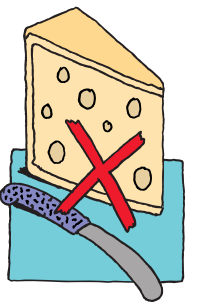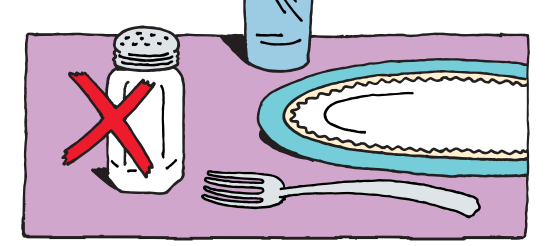
Food gives you the energy you need for healthy living. Your body changes most of the food you eat into a sugar called glucose.
Insulin helps your cells get the sugar (glucose) you need for energy. Insulin also helps keep your blood sugar levels normal. When you have diabetes, your body doesn’t make insulin or enough insulin, or the insulin it makes doesn’t work right.
 Healthy eating includes planning your meals, choosing healthy foods, and watching your weight. It also includes balancing what you eat and how much you eat with how active you are.
Healthy eating includes planning your meals, choosing healthy foods, and watching your weight. It also includes balancing what you eat and how much you eat with how active you are.
 The foods you eat change your blood sugar levels in different ways. You will learn how to make healthy food choices that help control your blood sugar.
The foods you eat change your blood sugar levels in different ways. You will learn how to make healthy food choices that help control your blood sugar.
Insulin helps your cells get the sugar (glucose) you need for energy. Insulin also helps keep your blood sugar levels normal. When you have diabetes, your body doesn’t make insulin or enough insulin, or the insulin it makes doesn’t work right.
Even though your insulin does not work right, healthy eating can help keep your blood sugar from becoming too high or too low.
Planning Your Meals
 Healthy eating includes planning your meals, choosing healthy foods, and watching your weight. It also includes balancing what you eat and how much you eat with how active you are.
Healthy eating includes planning your meals, choosing healthy foods, and watching your weight. It also includes balancing what you eat and how much you eat with how active you are.
Your doctor, diabetes educator, or a dietitian will help you plan your meals.
What you eat depends on:
- How much you weigh
- How active you are
- Your blood sugar levels
- The foods you like to eat
 The foods you eat change your blood sugar levels in different ways. You will learn how to make healthy food choices that help control your blood sugar.
The foods you eat change your blood sugar levels in different ways. You will learn how to make healthy food choices that help control your blood sugar.
If you take diabetes pills or insulin, you will also learn how to space your eating throughout the day. This will help your medicine keep your blood sugar under control.
Some people, especially active people, may need snacks in between their regular meals.
Follow your meal plan.
Try not to skip any meals or snacks.
Your goal is to:
- Eat healthy foods
- Eat the right amounts of food
- Eat your food at the right times to control your blood sugar.
Choosing Healthy Foods
A healthy eating pyramid like the one below will help you control your blood sugar.
Your goal is to eat a healthy balance of carbohydrate, protein, and fat. Carbohydrate is the body's main source of energy. Health exper ts recommend about half of the calories you eat each day be from foods high in carbohydrate, such as whole grains.
Eating foods high in fiber helps control blood sugar. Fiber can also make you feel full, which helps you to eat less.
High-fiber foods include:
- Fresh fruits and vegetables
- Whole grain cereals and breads
- Beans, peas, lentils, and legumes
- Brown rice, barley, and oats
Foods low in fat and salt
Fatty foods have more calories than other foods. Eating low-fat foods helps you control your weight. Diabetes can be harder to control if you are overweight. Eating less fat can also help prevent hear t disease.
- Cut back on butter, margarine, oil, salad dressing, and sour cream when eating or cooking
- Cut back on fatty meats, whole milk, cheese, fried foods, peanut butter, and chips
- Be careful about what you order in fast-food restaurants (fast foods often have a lot of fat)
Other ways to cut the fat in your diet: Remove the skin from chicken, and trim the fat from meat before cooking or eating it. Drink fat-free, low-fat or skim milk. Eat low- fat or fat-free cheeses and desser ts. Bake, grill, or broil food instead of fr ying it.
High blood pressure is a common problem in people with diabetes.Your doctor may ask you to eat less salt if you have high blood pressure.
Ways to cut down on salt:
- Don’t add salt to the food you eat or cook
- Don’t put the salt shaker on the table
- Use salt-free seasonings
- Such as garlic powder, onions, hot pepper, spices and herbs
- Stay away from high-salt foods such as lunch meat, pickles, chips, and pretzels
How Much Should You Eat?
Learn about ser ving sizes. It is an important way to help control blood sugar levels. One way to know how much food you are eating is to weigh or measure it. Use a measuring cup and spoons or a scale.
Most people eat more than they think. After measuring foods for a while, you will often be able to know a ser ving size just by looking at it.
Read Food Labels
Most foods have a nutrition label. Food labels are a big help in choosing foods that fit into your meal plan.
Always read food labels when you shop.
Write It Down
Keep a food diar y. This will help you see how your blood sugar is changed by what you eat, when you eat, and how much you eat.
Dining Out
If your have diabetes, plan ahead if you eat out. This will help you control you blood sugar.
Here are some ways to plan ahead:
- Find out what is being ser ved, in case you need to bring something that fits into your meal plan
- Drink water or diet soda, if you can
- In restaurants, order food grilled, baked, or broiled – not fried
- Ask for sauces and dressing to be ser ved on the side
- Always carr y a snack in case your meal plans change
About Alcohol
Talk to your doctor if you drink alcohol. If you take insulin or diabetes pills, your blood
sugar level may drop too low after you drink alcohol.
Don’t have more than one or two drinks a day. Be sure to test your blood sugar after drinking.
If you drink alcohol:
- Drink with a meal or right after eating
- Drink slowly
- Choose light beer or white wine
- Mix drinks with club soda, diet soda, or water
Healthy eating is impor tant for people with diabetes and ever yone else. You and your family can enjoy the same tasty, healthy foods.













Reviews:
Post a Comment